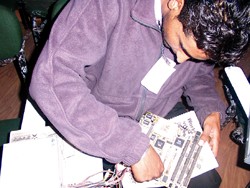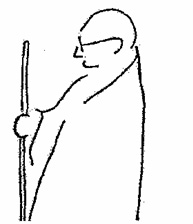|
TARAgyan@TARAhaat.com Sagarika Bose sbose@tarahaat.com T ARAgyan, the educational wing of TARAhaat, was set up to impart
meaningful, quality education to rural India, using the tools of Information and Communication Technology (ICT). The idea was to use the best technologies in ICT to create a shift in learning from the conventional one-way to a two-way system, from cramming to information assimilation, and towards meaningful infotainment. In TARAgyan,s we believe that education is a two-way process. Learning happens at both ends—at the level of learners, who learn new skills and techniques and at the level of course developers and facilitators, who get relevant feedback to make their products more effective and productive. However, this approach to learning did not develop overnight. When TARAgyan launched its first course, Basic Information Technology (BIT), in TARAkendras across Bundelkhand and Punjab in January 2001, we started off in a fairly conventional way. The courses were developed by experts and delivered on-site at TARAkendras by instructors trained by TARAgyan. However, we soon realised that something elemental was missing. While our courses were good, and our customers were happy, this was not universal. Given that the educational backgrounds of students across the TARAkendras are similar, some TARAkendras produced better performing students and this had nothing to do with the learners’ capabilities or the hard work they had invested in. The solution we hit upon was to design a training and monitoring system which would help us standardise the delivery of our courses as well as put in place an all-important feedback system to help us produce better programmes and study material. The approach we now follow is a combination of onsite blended learning led by local instructors and long distance support from expert mentors for both the learners and the instructors. Over the past three years, we have developed a strong support structure in order to provide quality programmes to our learners. We have focused our efforts on building a powerful training and certification programme for our trainers and instructors, a strong monitoring and evaluation system for course delivery and an innovative assessment method for evaluating learners. We learnt the hard way that simply developing good courses and training instructors does not ensure success. It is also very important to keep a check on the entire process—from course development to its delivery to the end user. Therefore, we have developed a reporting system for the field. Reports are sent by the instructors to the TARAgyan coordinators in the field each week. These reports consist of student attendance, lesson plans, problems being faced by learners and instructors, etc. Feedback on the reports, as necessary, is sent by the TARAgyan field coordinator or the course coordinator (based at the HO in Delhi). These help the instructors grow and develop into better facilitators. It also ensures a greater involvement of the learners as well as the instructors in the entire process.
Another major part of our work focused on course reviews and updates. We learned from our experiences that customisation to the learners’ needs is the order of the day. The closer we get to the learner, the easier it is for him/her to learn. This is true for the context in which they live, the languages they speak and the pace at which they learn. With this in mind, we graduated the Practical English Course (PEC) to the Practical English Learning Programme (PELP). We started out with one PEC course catering to multiple levels in 2001. Over the last two years, we felt the need for more than one course as we were not being able to address all our learners. The learners, with different socio-economic and educational backgrounds, have different comfort levels with the language. We, therefore, developed the PELP Foundation and the PELP Intermediate with plans for further courses based on learner needs. We have also revamped the BIT, TARALite and ‘Working with Series’ courses. We have made them much more interesting and learner-centric by looking at them from an application angle. The focus is on hands-on experiences rather than on theoretical exercises. Gone are the dry facts about history and development of computers. In its place there are interesting projects and assignments, which are customised to meet the needs of the learners. This will increase their confidence level and help them in real-life situations. For example, projects on writing well formatted cover letters for job interviews (professionals looking for jobs), preparing project reports (for school and college students), etc. The Master Effective Selling Course was developed keeping this very principle of application-based learning in mind. The course is facilitated instead of being taught and concepts are internalised through sharing of experiences, opinions, role plays and group discussions. Education is likely to remain one of the biggest revenue generators of TARAhaat. For this reason, we have to continue the development effort on new fronts. Some of the courses under development are a Hindi literacy programme, further IT courses such as Web designing and DTP based courses, etc. The literacy programme for adults, "Hum Bhi Sakshar Banenge", is an innovative ICT-enabled course to teach basic reading, writing and numeric skills to neo-literate and semi-literate adults. Our efforts have paid off and the rapidly increasing number of learners in our TARAkendras testifies to that. However, success often brings in complacency and sluggishness. It is very easy to sit back and view with pride the wealth of material and systems we have created. This is why we constantly challenge ourselves to better our achievements. q
|
 We are
introducing a certification programme for TARAgyan trainers and
instructors to maintain the highest standard of course delivery to keep
our personnel up-to-date. Our monitoring and evaluation system has
indicated that trainings and refresher trainings are useful in their own
way, but more than that we have to keep our personnel motivated and
challenged. Instructors and trainers would be certified annually under
this programme and they would be evaluated at the end of each year for
re-certification, based on performance in the past year as well as in
the refresher training. To this end, we designed and implemented a
three-day trainers’ workshop in January this year. The objectives of the
workshop were to standardise trainings; sharing and learning from peers;
and equipping trainers with tools to design and implement better
trainings.
We are
introducing a certification programme for TARAgyan trainers and
instructors to maintain the highest standard of course delivery to keep
our personnel up-to-date. Our monitoring and evaluation system has
indicated that trainings and refresher trainings are useful in their own
way, but more than that we have to keep our personnel motivated and
challenged. Instructors and trainers would be certified annually under
this programme and they would be evaluated at the end of each year for
re-certification, based on performance in the past year as well as in
the refresher training. To this end, we designed and implemented a
three-day trainers’ workshop in January this year. The objectives of the
workshop were to standardise trainings; sharing and learning from peers;
and equipping trainers with tools to design and implement better
trainings. 